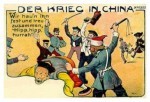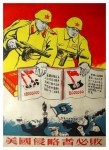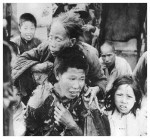
In October 1949, communist revolutionaries led by Mao Zedong seized control of China. The Chinese Community Party (CCP) was a relatively young group, formed in 1921 and inspired by the success of the Russian Revolution. Political and economic turmoil in China during the 1930s, coupled with Japan’s invasion of northern China, allowed Mao and the CCP to build support and work towards revolution. The CCP victory in China heralded a significant shift in global affairs. With a population of more than 540 million people, China was the most populous nation on Earth – and it was now in communist hands. In its first years the Cold War had focused on western Europe generally and the divided city of Berlin specifically. The Chinese Revolution opened up a new Cold War front in Asia. The communist victory in China also brought profound changes for the Chinese people. Communist China underwent modernisation and rapid industrial growth – but they were accompanied by authoritarian leadership, rigid social control and economic experiments culminating in mass starvation.
The seeds of the Chinese Revolution were nationalist rather than communist. Long regarded as the ‘sleeping dragon’ of the East, China had been a fertile prize for foreign imperialists. During the 18th and 19th centuries Europeans from several nations arrived in China. European merchants traded extensively with the Chinese, while Christian missionaries spread their religious beliefs and converted thousands of locals. By the late 1800s the British, French, Russians, Germans and Japanese had established spheres of influence (in effect, internal colonies) inside China. This foreign imperialism brought benefits for some Chinese but for the majority it produced only exploitation and misery. In their quest for profit and control, foreign imperialists subverted local rulers and undermined China’s social structures. The British defied a ban by Chinese rulers and introduced opium, an addictive narcotic, into the region. Opium production and trade grew in China, filling the pockets of British companies and turning thousands of Chinese into listless drug addicts.
The exploitation of China by foreigners fuelled an emerging nationalism. Many Chinese believed their people should fight for independence and liberation from foreign control. In 1899 a group calling itself the Society of Righteous and Harmonious Fists began attacking Europeans, Christians and foreign property in China. Western newspapers referred to these rebels as “Boxers”, a reference to their use of martial arts. Their anti-Western violence became known as the Boxer Rebellion; it lasted for two years before being suppressed by a coalition of eight Western nations. In 1911 a nationalist revolution overthrew China’s royal dynasty, the Qing. China began an optimistic but brief flirtation with republican democracy. The new government was weak, however, and failed to attract much support. By 1916 it had collapsed and China dissolved into a patchwork of regions, controlled by powerful warlords and their private armies.

The early 1920s saw the emergence of two new political parties: the nationalist Guomindang and the Chinese Communist Party (CCP). Both dreamed of a free and independent nation, ruled by the Chinese with no foreign political involvement, but the similarities in their aims ended there. The Guomindang was pro-capitalist and supported by conservatives, the middle-classes, business interests and the West, particularly the United States. The CCP represented China’s industrial working-class and peasant farmers, who comprised more than 90 percent of the population. In its first years, the CCP was both inspired and directed by the Soviet regime in Moscow. In 1927 the Guomindang and its military reined in the nation’s warlords, reunifying large areas of China and restoring national government. The Guomindang leader Jiang Jieshi (or Chiang Kai-shek), a vehement anti-communist, then turned his attention on the CCP, initiating a massacre of communists in their urban base in Shanghai. Thousands of communists were forced to take refuge in remote areas, where they regrouped by forming soviets (communist collectives).

With military aid from both the United States and Nazi Germany, Chiang attempted to encircle and destroy the communists. In 1934 thousands of communists fled their largest soviet, Jiangxi, and began a daunting 8,000-mile trek to Shaanxi in northern China. This Long March, as it was later known, became a turning point for communists in China. It allowed the CCP to avoid defeat and annihilation – but it also heralded the arrival of a new leader: Mao Zedong. In 1937, as the CCP was reforming and building a new Soviet in Shaanxi, China was invaded by Japan. Hostilities between the Guomindang and the CCP eased, as the two groups formed a fragile union to fight against Japanese occupation. But after Japan surrendered and withdrew from China in 1945, the two rival groups resumed their conflict. Years of corruption, mistreatment and pro-capitalist policies had made Jiang Jieshi’s government unpopular, particularly with China’s 400 million peasants. In contrast, support for the CCP and its promises of land reform and respect for the peasantry soared. The communists steadily gained ground and, in 1949, Jiang Jieshi and his cohort were forced to flee to the island province of Taiwan. In October that year, thousands rallied in Tiananmen Square, Beijing to hear Mao Zedong proclaim the birth of a new communist state: the People’s Republic of China (PRC).
“Mao Zedong announced in the summer of 1949 that ‘there could be no third road’ and that China must lean to one side, to the communist camp, in the Cold War. In the circumstances there was no alternative for the new and unconsolidated Chinese regime, although Mao was careful not to exclude the possibility of loans ‘on terms of mutual benefit in the future’ from the capitalist powers… Mao may well have supposed that the Cold War pressures for unity in the communist bloc would be used to forge a durable working agreement between China and the USSR, in which China would not be a mere satellite…”
Alan Lawrance, historian
The United States government already had its hands full with Soviet expansion in Europe, so the communist victory in China was deeply concerning. American agents had worked with Mao Zedong and his group during the 1930s when both were at war with the Japanese. Now the US refused to acknowledge the legitimacy of Mao Zedong and his CCP government. Washington instead chose to deal with Jiang Jieshi and the Guomindang in Taiwan, viewing them as the government-in-exile of mainland China. The US began to pay closer attention to south-east Asia. The successful revolution in China had opened up an ‘eastern front’ in the Cold War. Communism could now spread south through Asia, taking root in politically vulnerable states like Korea, Vietnam, Malaya and Indonesia. If these countries fell to communist movements, important US allies like the Philippines, post-war Japan and Australia would be isolated and at risk. Washington believed that China’s communists were largely controlled by Moscow. In reality, Mao Zedong was charting his own course and his relationship with Joseph Stalin was difficult.

During the early 1950s, the People’s Republic of China embraced policies similar to those of Stalinist Russia in the 1930s. All businesses were nationalised and private ownership of capital was prohibited. Beijing embarked on a land reform program, seizing property from landlords and redistributing it to peasants; the landlords were tried and vilified before village meetings and many of them executed. The new government’s main priority was to haul China out of medieval agrarianism through industrialisation and modern technology. Beijing fuelled this industrial rebirth with raw materials, machinery and thousands of technical experts from Soviet Russia. In 1953 the CCP government initiated its first Five Year Plan, an economic program that set ambitious goals for industrial and technological growth in China. This program was generally successful, producing dramatic increases in iron and steel production, electrification, coal mining, infrastructure and building projects. China’s military strength increased in line with its industrial capabilities. China’s development was so rapid that in late 1964 it test-fired its first nuclear weapon and joined the US, USSR, Britain and France as a member of the ‘nuclear club’.

But as in Soviet Russia, China’s rush into modernity came at an enormous human cost. The government’s second Five Year Plan (1958-62) – dubbed the ‘Great Leap Forward’ by Mao Zedong – was disastrous by any measure. After the economic advances of the mid-1950s, Mao became even more ambitious. Labour and resources were redirected into industrial production so that China might “catch up to the West” in just a few years. The Great Leap Forward set near-impossible production targets and quotas. This placed pressure on managers and workers, who submitted exaggerated or falsified production figures. The diversion of workers from farming to the industrial sector caused food production to decline, a problem exacerbated by a number of severe weather events and natural disasters. China’s industrial growth was consequently over-reported, while parts of the country were struck by severe food shortages. This led to a devastating famine that killed at least 10 million and possibly as many as 30 million Chinese, most of them peasant farmers.
The failure of the Great Leap Forward led to the CCP sidelining Mao Zedong from policy decisions. Mao retained his titular positions in the party and, more importantly, his prestige with the Chinese people. He returned to the spotlight in 1966 by organising a campaign against so-called ‘rightists’ (counter-revolutionaries) in the party, government and universities. This campaign evolved into the Great Proletarian Cultural Revolution, a mass movement dominated by young students. Utterly loyal to Mao and his ideas, these militant students formed uniformed brigades called the Red Guards. They rallied in support of Mao and formed gangs to denounce, intimidate and terrorise his perceived enemies. Among those targeted by the Red Guards were Mao’s political rivals, liberal-minded teachers and lecturers, government bureaucrats and foreign diplomats and embassies. Some Red Guards went as far as denouncing and betraying their own parents for being critical of Mao. The Cultural Revolution not only restored Mao’s authority and control of China, it created years of political authoritarianism, social disruption and economic paralysis.

1. Until the early 1900s, China was a weakly governed empire, dominated and exploited by Western powers. From 1927 China was ruled by the nationalist Guomindang, led by Jiang Jieshi.
2. The Chinese Communist Party was formed in 1921. After years of struggle and civil war, the communists eventually gained control of China in October 1949.
3. The communist victory in China created a radical shift in the Cold War. Previously focused on Europe, the US and the West now began to fear the spread of communism throughout south-east Asia.
4. Meanwhile, the communist regime in China embraced major economic reforms, seeking to transform their nation from a backward agricultural economy to an industrial and military power.
5. This process succeeded but came at an enormous human cost. Mao Zedong’s Great Leap Forward (1958-62) triggered a deadly famine that killed up to 30 million people. Later, his Cultural Revolution (1966) paralysed and terrified the nation.

Mao Zedong declares a new People’s Republic of China (1949)
A member of the Red Guards rebels against her teacher (1966)
A teenage girl denounces her parents during the Cultural Revolution (1968)
Content on this page is © Alpha History 2018. This content may not be republished or distributed without permission. For more information please refer to our Terms of Use.
This page was written by Jennifer Llewellyn and Steve Thompson. To reference this page, use the following citation:
J. Llewellyn et al, “Communist China”, Alpha History, accessed [today’s date], https://alphahistory.com/coldwar/communist-china/.
